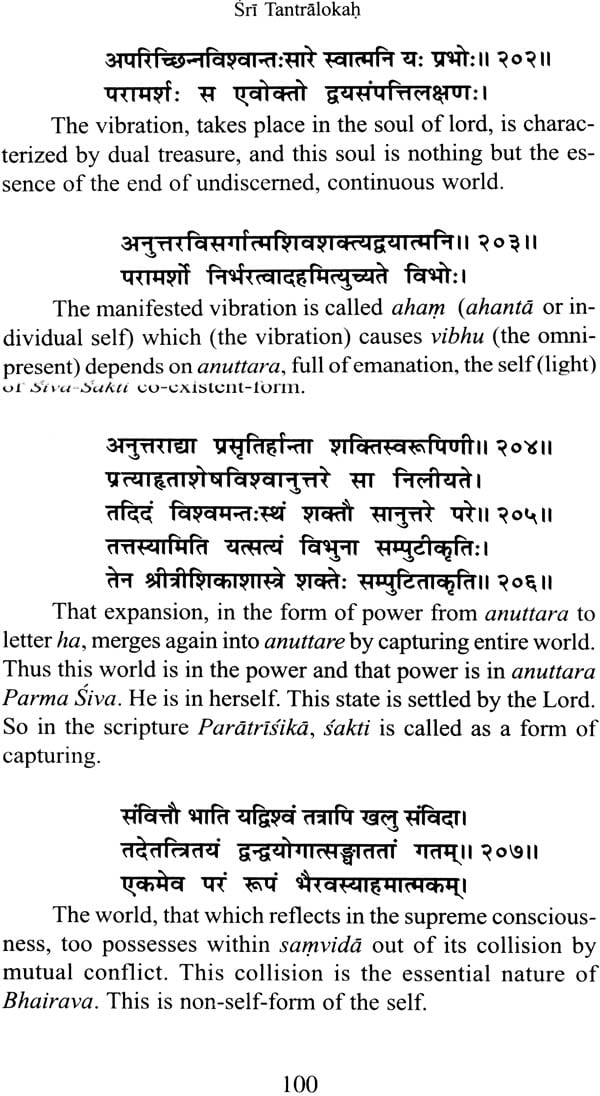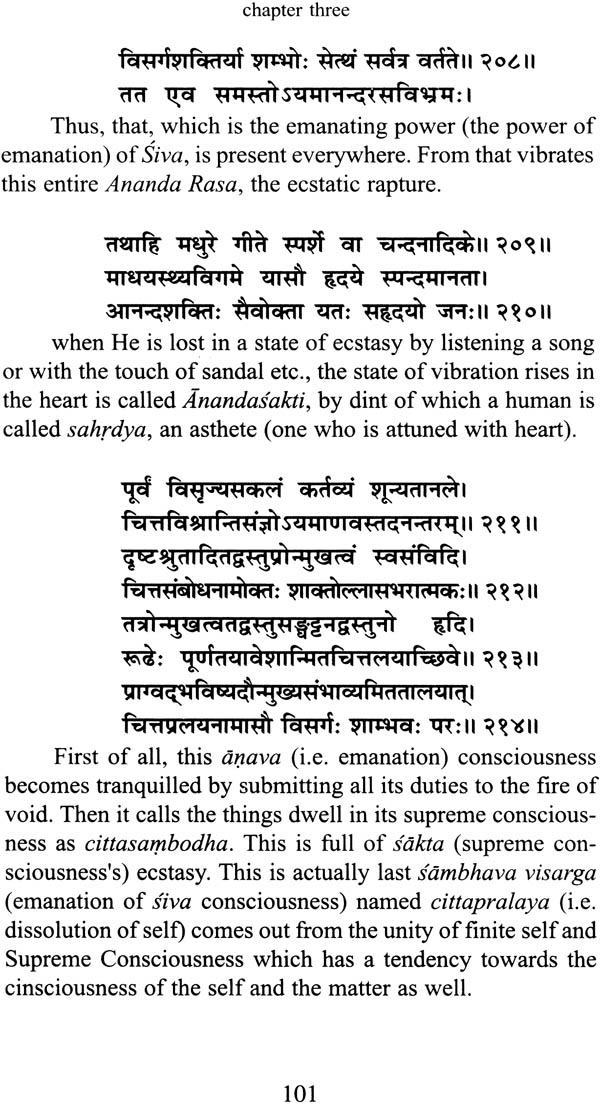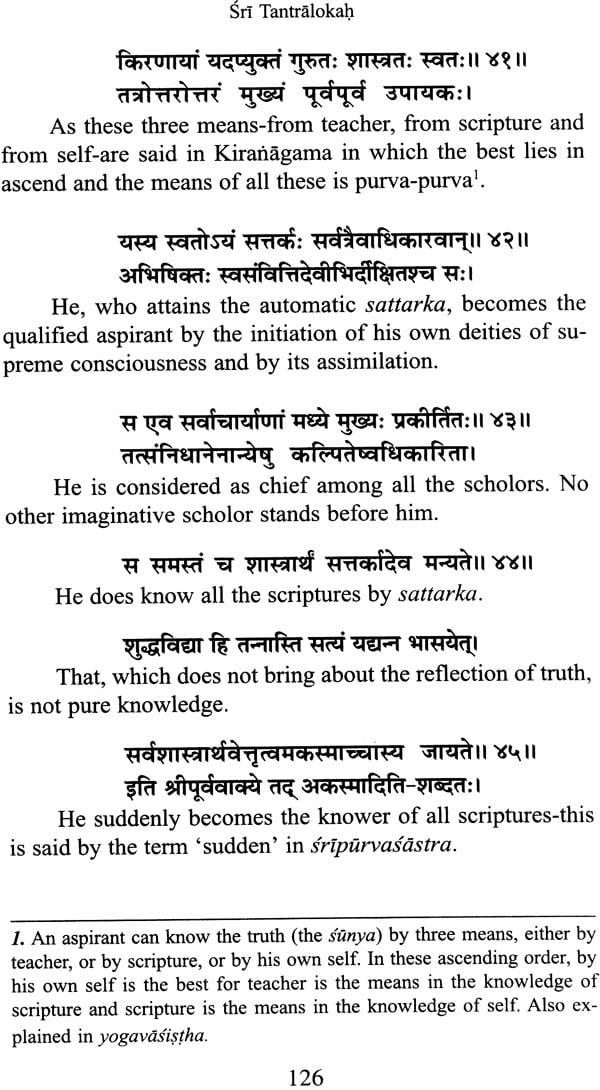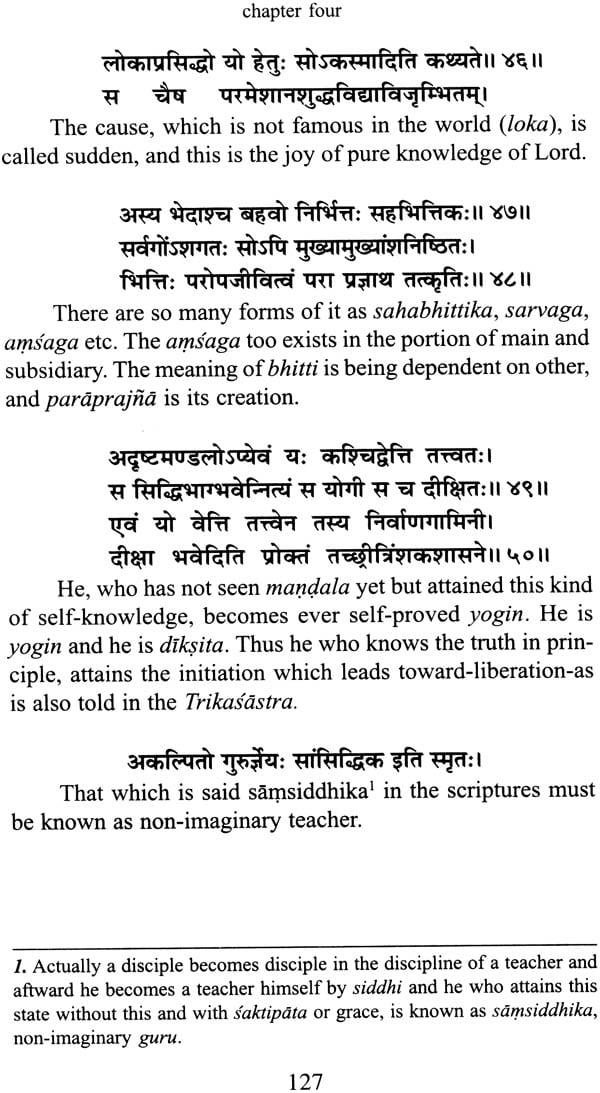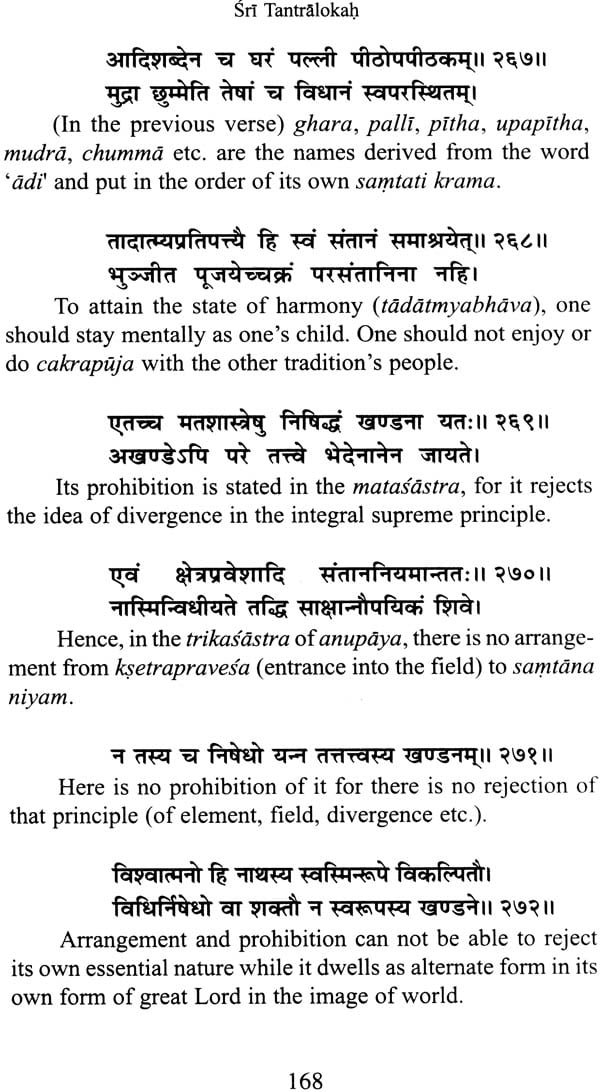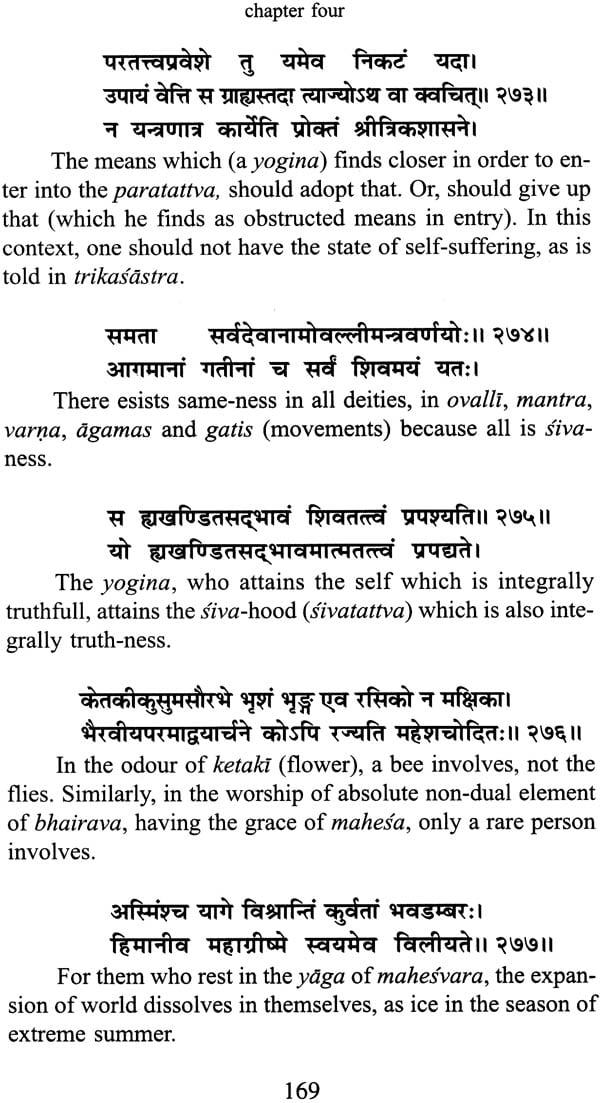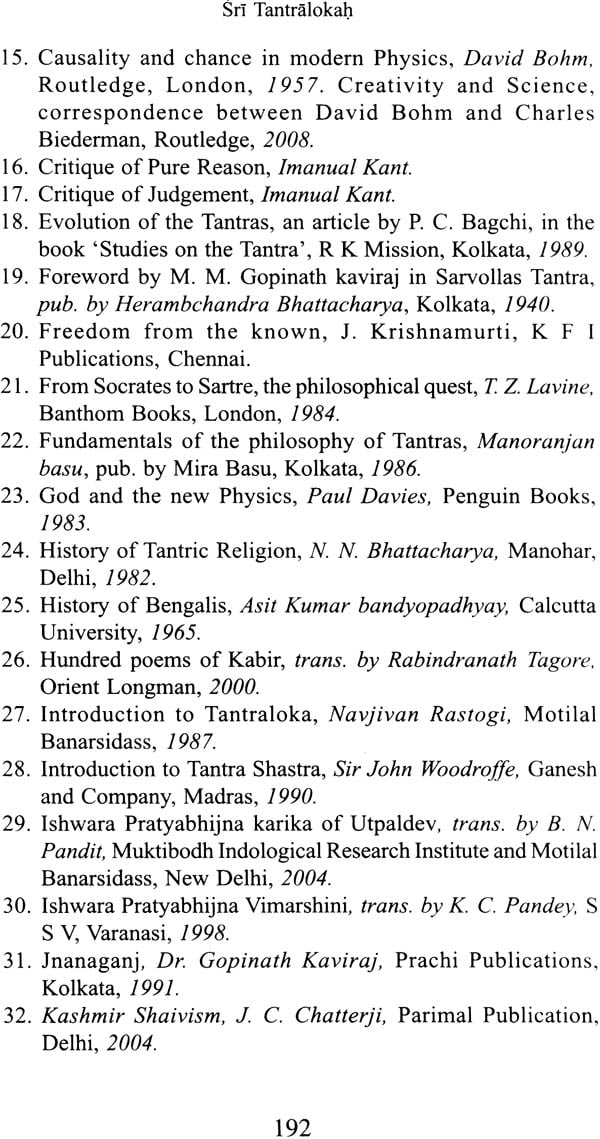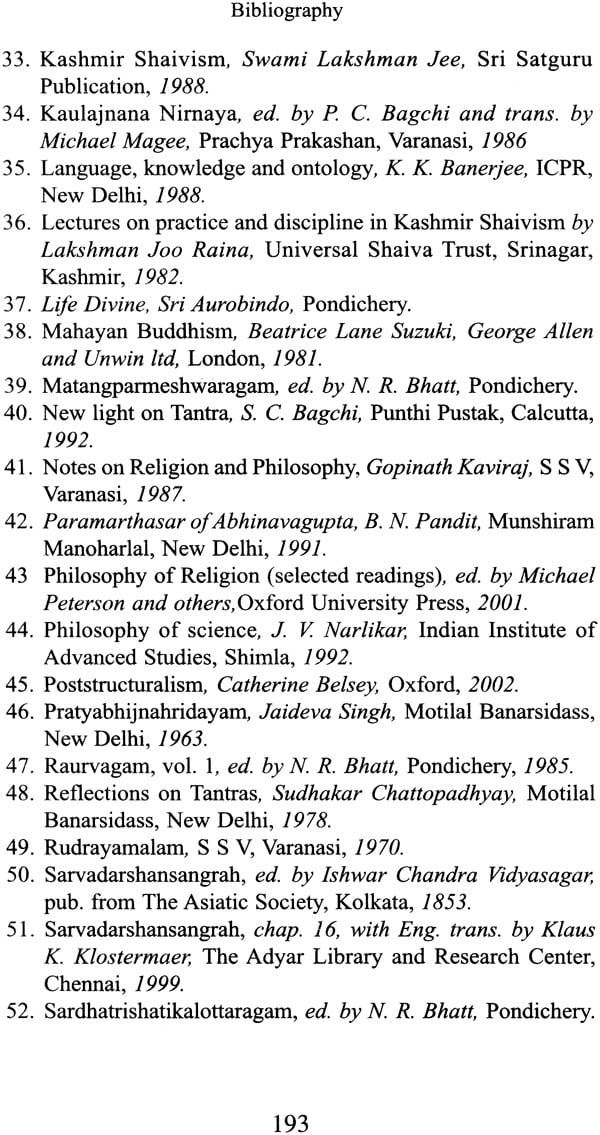
Sri Tantralokah - Volume II (Sanskrit Text with English Translation, Transliteration of Chapter Two, Three, Four)
Book Specification
| Item Code: | IDC025 |
| Author: | Gautam Chatterjee |
| Publisher: | Indica Books, Varanasi |
| Language: | Sanskrit Text with English Translation, Transliteration of Chapter Two, Three, Four |
| Edition: | 2008 |
| ISBN: | 8186177067 |
| Pages: | 244 |
| Cover: | Hardcover |
| Other Details | 8.8" X 5.8" |
| Weight | 450 gm |
Book Description
Foreword
Abhinavagupta's magnum opus 'The Tantraloka' is a great work in the ambience of tantragama treatise. This precept of right descriptions of almost all branches of saiva and sakta agama. The right will to translate the entire work into English (direct from Samskrta) is reflected in the mind of Mr. Gautam Chatterjee. As the result, the translation work of the ten chapters has been completed with illustrious explanatory notes. I pray to Lord Siva, who blesses with his Trisula of powers i.e. will, knowledge and action, may accomplish the translations of the entire work. I believe, all the scholars of the tantragama will appreciate this work with their blessings.
Situated on the upper portion of the Trisula of Jnanaguru Lord Samkara, Kasi, represents the whole world, so it is quite natural that people from Bengal come here and stay. In such a family, on 18th August 1963 (Bhadrapada masa), this child was born to enhance the joy of his mother Meera and father Amaresh Chandra Chatterjee, in order to flourish the grace of his lineage as his sun-sign is Leo (simhasthasurya).
Sisyaprajneva bodhasya karanam guruvakyatah', by such blessings from scriptures, the spiritual mother Rangama blessed and elevated this fortunate. After completing his education in science subjects from Banaras Hindu University, he cultivated his skill in the field of musicology, and drama-art. He performed his teachings in these subjects in Mahatma Gandhi Kashi Vidyapith. His mother Smt. Meera Devi was initiated (consecrated) by the ascetic Rangama and benefited by the teachings of great sages like Anandmayi Ma. M.M. Gopinath Kaviraja and others.
By the blessings of these great dignities, Gautam's interest arisen the spirituality. He mastered himself by the grace of great scholars like Swami Lakshman Joo, Sri Govind Gopal Mukhopadhyay, Thakur Jaideva Singh and others in the area of literature, music art and Pratyabhijnasastra. He interviewed art stalwarts such as Satyajit Ray, Kumar Gandharva, Kelucharan Mohapatra, Nirmal Verma Badal Sircar and others and published it with the concerned seminars. He had keen interest in journalism so he enriched the journals Dharmayug, Svatantra Bharat, Rastriya Sahara and the Hindu with his talent, and got great fame.
At present, with Abhinava Gupta Academy, busy with the scholarly works regarding Natyasastra and Pratyabhijnasastra, researches and seminars, Mr. Chatterjee is constantly engaged to accomplish his right resolves. I wish for the success of his zeal.
In 2006, he published his own collection of ten plays (as a playwright) 'Dasarupaka' in Hindi. In the preface of this book, he has discussed the ideas of his own and other scholars. Here, the effort is praiseworthy but we can not approve every idea presented in this preface. Here discussed topics as the Buddhist tantras are inspired by Gautam Buddha, there are effects of Tantras on Natyasastra, the period mentioned here of Guhyasamajatantra, Prapancasaratantra is the work of Adya Samkaracarya, the use of the word Sandha Bhasa (the twilight or upside down language) are expected to have genuine proofs. We must not forget that the Jains are more harmonious to the nation than the Buddhists.
In the English translation of 'the Tantraloka', Mr. Chatterjee has written valuable notes as required by the help of several works with great pain and hard work. His effort in this respect is very much appreciable. I stop myself by saying that this method should be followed in the entire work.
Back of the Book
Tantraloka is a magnum opus of the Indian Tantrika-world, written in the Tenth Century, in the light of Kashmir Saivism by the great polymath Sri Abhinavagupta. This great work does not only include all the philosophical and Tantrika essence of monistic Kashmir Saivism but is also often considered the apex of Indian Tantrika Philosophy. Abhinavagupta explains in detail in its thirty seven chapters the all-inclusive vision and way to truth, the Prakasa state of Parama Siva. This publication is the first attempt to unfold this Prakasa (Light) for the English-speaking horizon.
Gautam Chatterjee, well-known writer, President, Abhinavagupta Academy, has a lineage of Pt. Ishvara Chandra Vidyasagar, with deep Sanskrit tradition and has been a close associate of Thakur Jaidev Singh. His two books (collection of plays), related to Kashmir Shaivism, have already been published. At present, working on the inter-influence of Indian Classical Music and Agam.
'Re-cognition of Actor' is his forthcoming book.
Introduction
The philosophy of Indian Philosophy is not a-priori. But the worship of Siva or Rudra goes back to the Vedas. If we consider the excavation of Mohenjodaro and Harappa as pre-vedic (according to John Marshall's view over the Indus Valley Civilization, and also the views from R.C. Majumdar and A.D. Pusalkar), we can come across the found image of Pasupati, as Pulaskar writes, the representation of male gods, the most remarkable is a three-faced deity, has at least three concepts which are usually associated with Siva viz. that he is (i) trimukha (threefaced), (ii) pasupati (lord of animals, in Kamira Saivism, the term 'pasu' means individual soul, pasa means maya and pati means Lord), and (iii) yogisvara or Mahayogi. The first two aspects are apparent from the seal itself. The deity is sitting cross-legged in a padmasana posture with eyes turned towards the tip of the nose which evidences the yogisvara aspect of the deity. It has been suggested by some scholars that the Siva-cult was borrowed by the Indo-Aryans from the Indus culture but as there is a reference to Siva in the Rigveda itself. Siva may not be a later intruder in the Hindu pantheon.'
Again, in the Yajurveda we have the Satarudriya. The Taittiriya Aranyaka tells us that the whole universe is the manifestation of Rudra. Some of Upanisads, the Mahabharata and some Puranas glorify Siva or Rudra. We find Rudra in the Atharvaveda, Brahmanas, Upanisada and Sutras.
In the Puranas, Siva is demonstrated with two aspects, benevolent and malevolent. Siva is generally worshipped by 'linga' i.e. phallic form and 'in the shape of man' i.e. anthropomorphic from (greek anthropos means man, morphe means shape). The puranas invariably present Siva with a single head whereas the installation of Siva's image with five heads (pancamukhasiva), we find in religious place of worship like Varanasi (or Kasi), in both the Visvanatha temples. We also find lingas with five faces (pancamukhalingas), also known as pancavaktra (Pancavaktra mohadevah in Skanda Purana). The Ardhanarisvara form of Siva is too found in the Puranas. And finally the twenty-seventh chapter of the Vayu Purana explains in detail the eightfold from of Siva. Rudra, Isana, Pasupati, Mahadeva,Nilalohita, Sankara, Siva, Sadasiva, Sambhu, Vyomakesa, Trinetra, Trilocana, Tryambaka, Virupaksa, Nilakantha, Nilagriva, Srikantha, Sitikantha, Astamurti, Santa are few names, we can find these for Siva in the Puranas.
In Indian Philosophy, linga originally meant symbol or sign of creation, grammatically it is sex, and etymologically, linga and langala (plough, as Przyluski studied) are of austro-asiatic origin and the same thing. In nigama and agama, therefore we find clear traces of Siva from the ancient time, historically and religiously, as an essential cult. The sacred literature of the Saivas is called Saivagama. Srikantha places it side by side with the Vedas. Madhavacarya refers to the four schools of Saivism Nakulisa-pasupata, Saiva, Pratyabhijna and Rasesvara in his percept 'Sarvadarsanasamgraha, written in twelfth century. Here mentioned Saiva indicates the dualistic school of Siddhanta saiva, the belonging of Madhavacarya.
After six long centuries, Pandita Isvaracandra Vidyasagara found the copies of this precept 'Sarvadarsana samgraha' in the late nineteenth century. During this dark period, people were unaware of saivism and saivagamas of ancient India. No other traces were there in moghul period. Pt. Vidyasagara found one copy of the same Samskrta script in Kolkata and two more copies from Kasi. He edited the entire script, consisting of fifteen major philosophies of ancient and medieval India and 142, Bibliotheca India) in 1853. Pt. Vidyasagara was then principal of the Samskrta College, Calcutta. After receiving this book with Samskrta text, E.B. Cowell and A.E. Gough translated it into English with fifteen philosophies and published it by indicating in the index that Madhavacarya had compiled sixteen philosopies. Recently the sixteenth, i.e. the advaita philosophy of Samkara is published from Adyara Library and Research centre, Adyara, Chennai in 1999. Klaus K. Klostermaier has translated the Samskrta text into English.
Therefore he was actually Vidyasagara ji who brought about this great work of Madhavacarya into light so that, after the English version by Cowell and Gough, the whole world, we came to know about Kashmira Saivism or the philosophy of Pratyabhijna and scholars traced the major works of this non-dualistic school from the Kasmiri Panditas for the very first time in late nineteenth and early twentieth centuries.
Therefore he was actually Vidyasagara ji who brought about this great work of Madhavacarya into light so that, after the English version by Cowell and Gough, the whole world, we came to know about Kashmira Saivism or the philosophy of Pratyabhijna and scholars traced the major works of this non-dualistic school from the Kasmiri Panditas for the very first time in late nineteenth and early twentieth centuries.
In his preface Pt. Vidyasagara writes: writes: There are two manuscripts (of Sarvadarsanasamgraha) in Calcutta, one in the Library of the Sanskrit College, and the other in that of the former manuscripts was sufficiently correct. But scrutinizing it with the care necessary for publication, I collected it with the copy in the Society's Library and found that without the more manuscripts, the readings in several passages in which the two manuscripts differ, could not be reconciled. No other manuscripts were however procurable in Bengal, but by good fortune I procured three manuscripts from Benares. These were of essential service to me, and it was only after carefully collating them with the texts in Calcutta and that I have been able to edit the work. I feel it my duty here to express my great delegations to Mr. Edward Hall, late of the Benaras College, through whose kind exertions the Bengares manuscripts were received.
Hence the Saiva system (or systems) came to the notice of the modern scholars in 1858 A.D. The four- The Nakulisa-Pasupata system, the Saiva system, the Pratyabhijna or Recognitive system ans the Resesvara or Mercurial system-among sixteen systems appeared for the first time when these published in the Bibliothica Indica. Inspite of that, the Pratyabhijna Sastra remained unknown to the modern scholars. In the years 1875, G. Buhler discovered in Kasamira (Kashmir), the works composed by Kashmiris under the general name Saiva Sastra. The available Literature shows that there were eight system of the Saiva Philosophy as-Pasupata, Siddhanta, Nakulisa Pasupata, Visistadvaita Saiva, Visesadvaita Saiva, Nandikesvara Saiva and Monistic Saiva of Kashmira. Abhinavagupta, the great polymath of Kashmira, has categorized these as three Saiva systems Dvaita, Dvaitadvaita and Advaita. Besides the four among sixteens in Sarvadarsanasamgraha, we find two more sects-Kapalika and kalamukha, in Yamuna's Agamapramanya. Saivism is again divided into Vira Saivism (or Sakti visistadvaita) and Saiva Siddhanta. The former is also known as Ligayata (or Satasthala). Though according to Sripati Pandita, Vira Saivism is Visesadvaita and not Sakti Visistadvaita. Scholars regarded this as Sakti Visistadvaita. K.C. Pandey puts this is the category of Visesadvaita. I consider this as sakti visistadvaita on the authentic basis of Puranas and my revered guru Pt. Vraja Vallabha Dvivedi. Saiva Siddhanta calls itself Suddhadvaita, the name while Vallabha's school bears. Whereas Vallabha means by the word 'Suddha' 'that which is free from the impurity of Maya (mayasambandharahita) and by the word 'Advaita's 'the Non-dual Brahman', Saiva Siddhanta takes the word 'Suddha' in the sense of 'unqualified' and the word 'Advaita' in the sense of 'Dvaita devoid of duality' which means that difference is real in existence. That means, though, matter and souls are real yet they are not opposed to Siva but are inseparably united with Him who is the supreme reality. This suggests the influence of Aprthaksiddhi of Ramanuja. Saiva Siddhanta agrees with Madhava in giving them substantive existence. Siddhanta Saiva is dualistic and Madhavacarya had faith in this dualistic philosophy.
Saiva Siddhanta recogonizes eighteen Agamas whereas Saivagamas are twenty eight. In Sarvadarsanas-samgraha, chapter seventh, the saiva darsana talks about Srimad Mrgendra, Karana, Kirana, Bahudaivatya, Puskara and Tantra doctrines. Colebrook found five books of Saiva sutras. He says, one is in the five, called the Pasupati sastra, which is probably the work quoted by Madhava in his account of the Nakulisa Pasupatas.
Saiva Siddhanta is known as Southern Saivism and Pratyabijna or Kashmira Saivism represents the Northern Saivism. It was primarily dualistic. This Northern school is known as Pratyabhijna or Trika or Spanda system as Kashmira Saivism. In short, historically, Siva-sutra (these have been revealed to Vasugupta, as it is said). Vasugupta's (eighth century) spanda karika or Spandamrta, Somanand's (ninth century) Siva drsti, Utpaldeva's (son and disciple of Somanand Nath, tenth century) Pratyabhijna-sutra, Abhinavagupta's (950 1025, disciple of Laksmanagupta) Tantraloka, Pratyabhijnavimarsini, Paratrimsika Vivarana and Paramarthasara (mainly), Ksemaraja's (pupil and cousin of Abhinavagupta) Sivasutravimarsini, Spandasandoha and Spandanirnaya, Kallata's (chief disciple of Vasugupta) Svarupa and Vibhuti Spanda and Vijnana Bhairava and some of the most important works of this system. Spandasandoha, by Ksemaraja, is a commentary on the first verse of Spandakarika, and Spandanirnaya, is a commentary on the first verse of Spandakarika, and Spandanirnaya, a commentary on the Whole book. Actually he has divided karikas into four sections. The commentary on the first section consisting of twenty five verses is Svarupa-spanda, second section is Sahajavidyodaya and the third is Vibhutispanda.
This system is based on Saiva agamas. Saiva literature or trika system can be vividly and broadly divided into three disciplines: Agama Sastra, Spanda sastra and Pratyabhijna Sastra. In their verbal meanings, the words or terms 'agama' and 'tantra' are different. These are acrostic words like 'bhairava'. But the Saiva literature regarding Agama Sastra can be considered or named as tantra. These are Malinivijaya, Svacchanda, Mrgendra, Rudrayamala, Sivasutras, Vijnanabhairava, Tantraloka etc. Spanda sutras or Spanda Karikas are Spanda sastra. Sivadrsti, Isvarapratyabhijna (and its vimarsini and vivrtivimarsini), Paramarthasara and pratyabhijnahrdayam are Pratyabhijna Sastra. We put the Tantraloka (magnum opus, work in twelve volumes by Abhinavagupta) and Tantrrasara (or tantralokasara, the essence of Tantraloka, in one slim book) in the category of Pratyabhijna Sastra. Pratyabhijna is Re-cognition. This Samskrta word 'Pratyabhijna' has the same connotation and verb-meaning as' abhhijna and 'abhijnana', meaning Recollection or Remembrance of what is forgotten which we knew before. We find this word in ancient texts like Logic or Nyaya Sutras of Gautam, Paccabhija in Buddhism and for the same verbal meaning, 'Anagnorisis' in Greek literature.
Pratyabhijna is re-cognition, to recognize, slightly different from remembrance. A love-sick woman cannot get any consolation and joy even though her lover may be present near her until she recognizes him. The moment recognition dawns she becomes all joy. She does not need to remember. She recognizes him at once because she had not forgotten him. She knew her before, and knows him even from vismrti (forgetfulness) to smrti (remembrance) is abhijnana, like in the story of Dusyanta and Sakuntala. The simile of the love-sick woman is else to the purpose of pratyabhijnna than the simile of Dusyanta. Let us take the later simile as approach. The remembrance takes place into the mind of Dusyanta as sphota, i.e. the meaning of something explodes into the mind of Dusyanta so that he is now able to recognize Sakuntala as his wife which he had forgotten. Similarly, the modern pandits of Kashmir Saivism say that 'I have forgotten that I am world of suffering, for I am wondering in this world of suffering, for I know but have forgotten, so remembrance is must. Now I have the remembrance that 'I am that' or 'you are me' i.e. 'tat tvam asi'. This is Recognition and this at once overcomes bondage. The liberated soul becomes one with Siva and ever enjoys the mystic bliss of oneness with Lord and dissolves into Jivanamukti.
And the other approach is that 'There is' and I have to recognize there is that which is, that 'I am that' that emptiness, the Siva. And this can happen in one single life, happen in one single moment. This entire world is full of reality. The word 'reality is derived from 'res', thing (like the word 'true' derived from Latin 'verus', means 'that which is', or German 'wahr', the English root meaning of the word 'True' is 'honest and faithful'. And the root of the English word 'thing' is fundamentally the same as the German 'bedingen', means to condition, to set the conditions or determine). Hence the reality is that which is conditioned in time and space, subject to birth, grow decay and death. So this world of such reality- where every 'thing' is interrelated, interdependent is actually the content of human consciousness, as J. Krsnamurti used to say. Whereas Siva means that which is good, benevolent, tranquility, ecstasy, freedom, all in absolute sense. Reality is relative, really. We can look at this reality outside and inside, as witness, put the things in order and can negate the order. Emptiness happens in serene silence. Because thought is thing or things are thoughts, as Bishop Berkeley used to say. No-thing-ness is the void or emptiness within the human consciousness which exists as 'that is' as Samkara, means, sam (in Indian Dramaturgy, sama is the permanent emotion, sthayi bhava of santa rasa, Abhinavagupta has described in his commentary 'Abhinava Bharati of Indian dramaturgy Natyasastra of sage Bharata in detail where he talks about sahrdaya who is having a mind of 'vimala pratibha'. Adhikari catra vimalapratibhanasalihrdayah. This pure intelligence, he also describes in the third ahnika of Tantraloka as a key word nirmalatva, the stainless purity) karoti iti samkara, means, He who puts out or extinguishes all the animal impulses as dross which are nothing but the thought-constructs or ideation, vikalpas, is Samkara. This citta, full of real things, thoughts can transform into citi (the technical term of Kashmira Saivism for pure consciousness), devoid of all vikalpas. And Kashmira Saivism provides that an individual soul can start with a pure thought, suddha vikalpa that I am Siva and this entire world is my own grand splendour, vibhuti or vilasa out of my own svatantrya.
So primarily Kashmira Saivism was a philosophy of dualismahanta and idanta, subjective and objective consciousness and after that is spread out all over the realm of wisdom as visvahanta or visvamaya and visvottirna, immanent and transcendent. This is the central philosophy of Kashmira Saivism, emerged in the ninth century A.D. as a monistic saivism. He is Anuttara, state of Parama Siva, the Highest Self, the Absolute, one than whom nothing is higher, the first vowel 'a', the Prakasa aspect of 'a'. Vimarsa is his glory, this world, contrast to Samkara's maya. Here it is positive, creative, vimarsa aspect of the Absolute Reality.
'Tantraloka's is a creation of Acarya Abhinavagupta, a compendium of all tantra texts available in several forms as works, akara grantha, a mine of great wisdom where each and every perspective of tantra (is regarded as Sruti or Agama, revelation as opposed to a Smrti or Nigama, "Tradition, pancama veda, 'Srutisakhavisesah', Nisvasatattva Samhita, one of the oldest available tantra, comprehends-meaning to hold it all together-that Tantra is the culmination of the esoteric science of the Vedanta and the Samkhya. Another old Tantrika text, 'Pingalamata' says, the Tantra, first communicated by Siva, came down through tradition. It is Agama with the characteristics of chandas (Vedas). Vaidika mahavakyas, like Prapancasara. Tanyate vistarayate jnanam anena, i.e. by which knowledge is pread or developed is Tantra) is elaborately explained. It seems at first glance that this is a grantha of upasana, text of worship rituals, at a great extent it is but actually this consists of the entire philosophical wisdom of Kashmir Saivism, that's why this is put in the pratyabhijna sastra, not in the category of agama sastra, for it contemplates (manana or vicara) over the principles (tattvas) and pratyabhijna sastra is actually manana sastra or vicara sastra.
So this system says simply that jiva is siva. Siva himself has five doings, pancakrtyakam-manifestation (srsti), maintenance, (sthiti), withdrawal from manifestation (samhara), concealment (vilaya or svarupagopan) and grace (anugraha or saktipata or svaprakasa).
svarupagopanam krtva svaprakasah punastatha.
(Tantraloka, chapter one, sloka 223)
So, Siva, by his fourth doing, has forgotten that he is Siva and considered himself as jiva. He has to re-cognize himself again by his own grace and the recognition dawns that He is Siva. This is just as caitanya. Caitanya plays and attempting into caityana, contemplating one caitanya to be caitanya again. This is His parasakti or samvid sakti or citpratibha who is trying, the niscayatmikasakti the answering mind of individual soul, Krsna (as in Pancaratra) sometimes Bhairava (as in matangatantra, by the use of anpratyaya of taddhita, is not matangatantra, this is 'Matanga paramesvaragama', not of dual siddhanta saiva, but saiva agama) and sometimes Bhairavi (as in the Saktatantra) according to M.M. Pt. Gopinatha Kaviraja. Jiva is samsayatmika sakti, the questioning mind as Arjuna in Gita or bhairavi in Vijnan Bhairava This state is Sadasiva.
gurusisyapade'pyesa dehabhedo hyatattvikah.
(Tantraloka, chapter one, sloka 256)
Liberation or salvation (mukti or moksa) is the meaning, goal and ever-relevant light of Asian country India and Indian philosophy. From pre-Vedic period to this post modern age, this essence of Indian philosophy is still remaining. In quantum, liberation does not depend on time or space, on birth and death. It is simply Self-realization depends on this life only, here and now. In one single verse, Acarya Abhinavagupta has put it in an impeccable way before the messy conglomeration of several concerning to salvation or moksa. He says:
svarupam catmanah samvinnanyattatra tu yah punah.
(Tantraloka, chapter one, sloka 156)
Meaning, the salvation is nothing else but the essential nature or form of one's own self, the awareness of one's true nature. This is named Atmasamvit in Pratyabhijna philosophy.
This voluminous work Tantraloka consists of thirty seven chapters (ahnika). This last (Sloka) of the last chapter is:
siva nisamaya tavat sarvatah srotratantrah
tyabhinavaparitusto lokamatmikurusva.
(O Siva! Please listen to this work, not work but the principles, sastratattva, which is presented in the best form by Abhinavagupta for you are omniscient. This is my praise or eulogy for you. Since this is the discussion or commendation about your form as beauty, so assimilate the world by satisfying with this ever-new praise.)
The pratyabhijna philosophy talks about thirty six principles, the Atman, The process of manifestation through Maya, The Transcendent Parama Siva, Five principles of the Universal subject-Object, The limited individual experience with the three coverings (Kancukas), Two Principles of the limited individual subject object, principles mental operation, The principles of materiality are some main doctrines of the Pratyabhijna system.
So, to recognize that emptiness, full of active energy as Parama Siva, is the principle of Re-cognition philosophically. Tantraloka offers its practical side as well. Here the light is conspicuously visible and impeccably inescapable. This system, historically, is found from the time of Tryambaka and Durvasa. This system, historically, is found from the time of Tryambaka and Durvasa. This system is also known as Trika-sasana, Trika sastra and Trika Darsana from Rahasya Sampradaya and Sivagama. We find a lineage or karma from Vasugupta and Somananda (9th century) and till the disciples of Abhinavagupta (11th century). In Kashmira, Abhinavagupta is regarded as Mahamahesvara. His origin & lineage, father Narsimhagupta and ancestor Atrigupta shifted to Kashmira from Kannuja (U.P.) by the king Lalitaditya (of Kashmir) in 8th century A.D. according to the version of Abhinavagupta, Bandyopadhyaya, Mukhopadhyaya, Gangopadhyaya and Bhattacharyas were shifted to Kolkata from Kannauj, the then capital of the state of Gurjar Pratihara in 9th and 10th century, now known as Uttar Pradesh, as described by Asit Kumar Bandyopadhyaya in his book 'Bangalira Itihasa') Laksamanagupta was Abhinavagupta's teacher. Narsimhagupta, Utpaldeva, Bhattatauta were his other teachers. He has created so many Independent treatises as Tantraloka, Tantrasara, Bodhpancadasika, Paratrimsika vivarana, Devibhujanga (found in Visvabharati), Malinivijayavarttika, Bhagavad Gitartha samgraha, Paramarthasara, Abhinava Bharati (Natyasastra vivrti), Dhvanyolokalocana,
Isvarapratyabhijnavivrtivimarsini, Anuttarastika etc. Ksemaraja and Jayaratha were his disciples. Jayaratha has made commentary on his 'Tantraloka'.
I have translated this work 'Tantraloka' from the original samskrta text of the K S T S (Kashmir series of text and studies) and found the other texts are inescapably incorrect. Somananda regards sage Durvasa as his manasa guru, in the similar way I regard Acarya Abhinavagupta as my manasa guru. Prof Vrajavallabha Dvivedi who has written his foreword in my initiating volumes of Tantraloka. Is my revered teacher in the area of Agama and Samskrta. By dint of their grace, I am presenting these volumes. The entire work will be concluded in twelve volume, as I hope. This is the second volume, including the ahnikas two, three and four.
This work determines that the caitanya is always there with the forgotten Siva as jiva as grace without which one can not perform his trident (Trisula). This is truly the Anuttara state, (or Anuttars dhama, as Abhinavagupta stated this term in the 37th chapter of his commentary on Natyasastra and at the end of second ahnika of Tantraloka) the fourth witnessing state of jiva as AUM who is simply aware of what Gautam Chattopadhyaya is performing as forgotten Siva or jiva with His powers of will, knowledge and action. Only these are the powers in the energy field of capacity of an individual soul which one can do without knowing destiny but the grace is there. Sakti can breath the power and instruction of Siva to perform. When one recognizes his or her beloved, at once becomes the grace the Siva. This is Love, unconditional, agape. The serene silence.
Back of the Book
Tantraloka is a magnum opus of the Indian Tantrika-world, written in the Tenth Century, in the light of Kashmir Saivism by the great polymath Sri Abhinavagupta. This great word does not only include all the philosophical and Tantrika essence of monistic Kashmir Saivism but is also often considered the apex of Indian Tantrika Philosophy. Abhinavagupta explains in detail in its thirty seven chapters the all-inclusive vision and way to truth, the Prakasa state of Parama Siva. This publication is the first attempt to unfold this Prakasa (Light) for the English-speaking horizon.
GautamChatterjee, well-known writer, President, Abhinavagupta Academy, has a lineage of Pt. Ishvara Chandra Vidyasagar, with deep Sanskrit tradition and has been a close associate of Thakur Jaidev Singh. His two books (collection of plays), related to Kashmir Shaivism, have already been published. At present, working on the inter-influence of Indian Classical Music and Agam.
'Re-cognition of an Actor' is his forthcoming book.
| 1 | Foreword | 9 |
| 2 | Introduction | 11 |
| 3 | Prefatory Note | 21 |
| 4 | Explanatory Notes | 23 |
| 5 | Suggestions | 43 |
| 6 | Chapter Two | 45 |
| 7 | Chapter Three | 61 |
| 8 | Chapter Four | 143 |
| 9 | Glossary of Technical Terms | 219 |
| 10 | Index | 235 |
| 11 | Bibliography | 237 |
